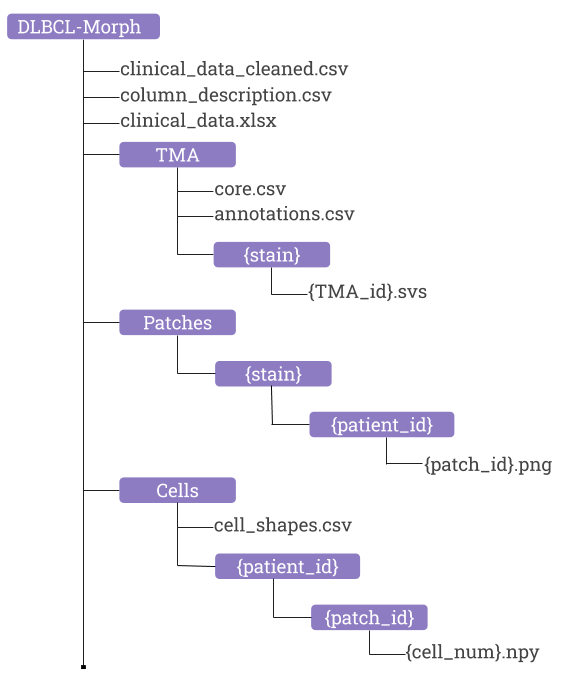DLBCL-Morph: Morphological features computed using deep learning for an annotated digital DLBCL image set
DLBCL-Morph is a dataset containing 42 digitally scanned high-resolution tissue microarray (TMA) slides accompanied by clinical, cytogenetic, and geometric features from 209 DLBCL cases as described in "DLBCL-Morph: Morphological features computed using deep learning for an annotated digital DLBCL image set".
Diffuse Large B-Cell Lymphoma (DLBCL) is the most common non-Hodgkin lymphoma. Though histologically DLBCL shows varying morphologies, no morphologic features have been consistently demonstrated to correlate with prognosis. We present a morphologic analysis of histology sections from 209 DLBCL cases with associated clinical and cytogenetic data. Duplicate tissue core sections were arranged in tissue microarrays (TMAs), and replicate sections were stained with H&E and immunohistochemical stains for CD10, BCL6, MUM1, BCL2, and MYC. The TMAs are accompanied by pathologist-annotated regions-of-interest (ROIs) that identify areas of tissue representative of DLBCL. We used a deep learning model to segment all tumor nuclei in the ROIs, and computed several geometric features for each segmented nucleus. We fit a Cox proportional hazards model to demonstrate the utility of these geometric features in predicting survival outcome, and found that it achieved a C-index (95% CI) of 0.635 (0.574,0.691). Our finding suggests that geometric features computed from tumor nuclei is of prognostic importance, and should be validated in prospective studies.
DLBCL-Morph is publicly available at this link: https://stanfordmedicine.box.com/s/ub8e0wlhsdenyhdsuuzp6zhj0i82xrb1
Below we walk through the code files in this repo.
The data_cleaner.py is used to create clinical_data_cleaned.csv from clinical_data.xlsx.
The notebook extract_patches.ipynb shows how patches were extracted from the TMAs inside the ROIs.
The notebook visualize_geometric_features.ipynb illustrates the fitting of a rectangle and an ellipse to any tumor nucleus, and computation of associated geometric features.
The notebook survival_regression.ipynb reproduces the Cox model results in our paper.
The scripts derive_shape_factor_matlb.py and extract_res.m computes all the geometric features that can be found in cell_shapes.csv. Matlab is required to run these scripts.
If you use the DLBCL-Morph dataset, please cite our paper:
@misc{vrabac2020dlbclmorph,
title={DLBCL-Morph: Morphological features computed using deep learning for an annotated digital DLBCL image set},
author={Damir Vrabac and Akshay Smit and Rebecca Rojansky and Yasodha Natkunam and Ranjana H. Advani and Andrew Y. Ng and Sebastian Fernandez-Pol and Pranav Rajpurkar},
year={2020},
eprint={2009.08123},
archivePrefix={arXiv},
primaryClass={cs.CV}
}
